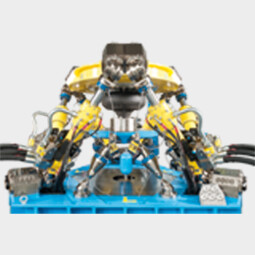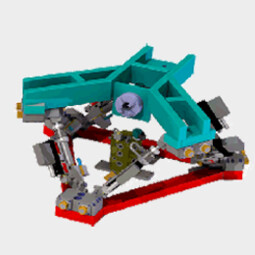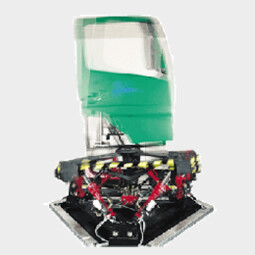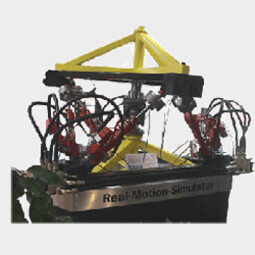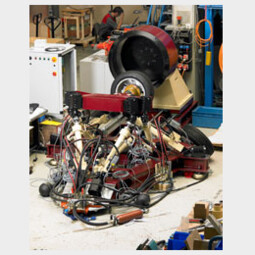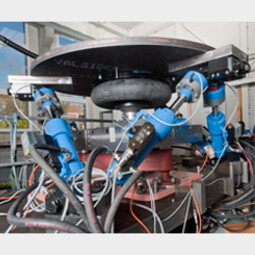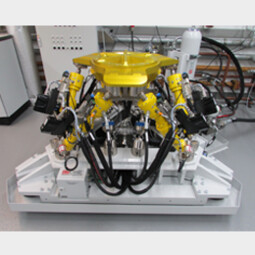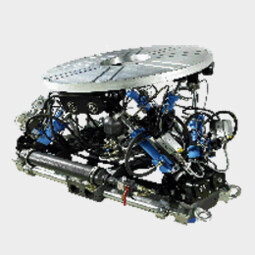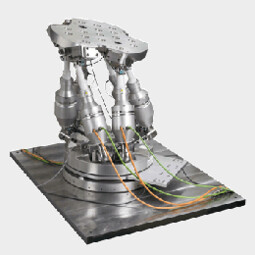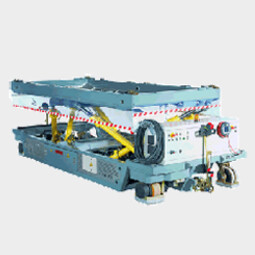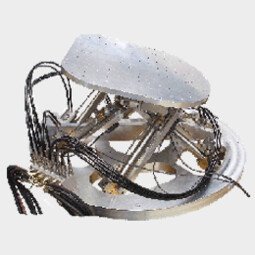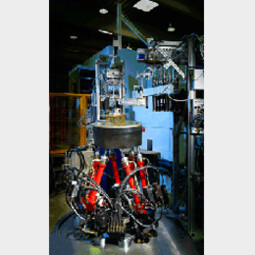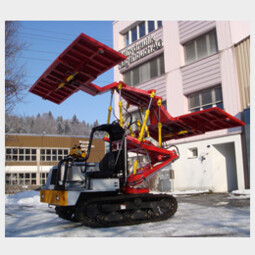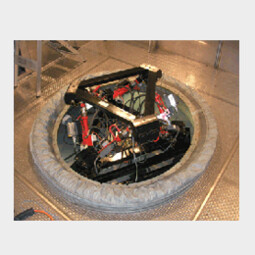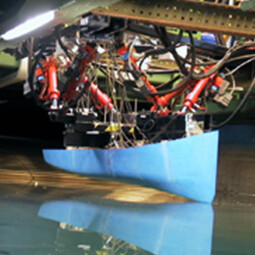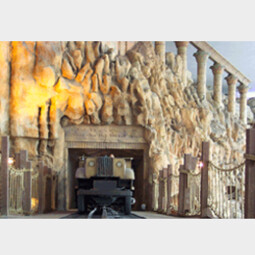Hexamove applications
Hexapod as a flexible testing machine
A new generation of software allows the mixing of displacement and position signals in Drive-Files. Each degree of freedom can be individually programmed as displacement or force signal. The test bench reaches up to 200 kN vertically and up to 100 kN horizontally. The torques ranging up to 25000 Nm. Using a step programming with function blocks the user can write complete automated process programs. This can also contain loops and let the control of data recording and external signals to.
Dynamic deforming and bending
The interesting cost-benefit ration makes the shaker hexapods the ideal engineering and inspection tools for suppliers of the car industry. The components are clamped horizontally between the propulsion part and a frame for this application. Work piece reception similar to a lathe facilitates fast installation times. The movement programmes are applied by the controls to a freely selectable work piece coordinate system.
Component-Testing in the automotive-industry
The Real-Motion-Simulator (RMS) allows a very accurate replay of drive-files based on data-recording at test-roads with real vehicles. The simulation in the laboratory brings high flexibility and new options in testing. The simulator allows to adapt test-conditions and to simulate motion which is very difficult to test on real vehicles or only at high costs. The 6DOF-System brings all these functions at very interesting costs. The 6DOF-System is also an interesting option when not all degress of freedom are used, but when other special test-benches can be simulated or replaced.
Hexapod for 6DOF-force-control and force-measuring
Hexamove testing machine with power take-offs clamp the test item between the upper and the lower frame. Typical applications are individual components or assemblies, which will be exposed to movements in 6 degrees of freedom. Clamping consoles are adapted for the test items.
Power metering can ensue directly at the component or all propulsion can be equipped with a power metering box. Axis-related forces will be translated by the master into Cartesian forces relating to the component. The drive file editor constitutes a comprehensive tool to record an analyse measuring data.
Depending on the component either direct or indirect adaptive power regulation is recommended. For the indirect power regulation the movements of the system are readjusted, so that the measured forces on the component follow the nominal value curve.
At the depicted test station the rubber dampening elements from heavy rolling stock will be exposed to stress in 6 degrees of freedom. The movement profiles are based on measurements at the rolling stock itself. The test station serves to receive component characteristic lines and to execute life span tests. A special strength of the controls it that the pivot point (work piece coordinate system) can be pushed to the centre of the component easily. Forces and paths are programmed in Cartesian coordinates relating to this zero point.
Wheel testing machine with displacement and force-control
This system makes it possible to define whether the forces and distances should be adjusted for each translation and rotation axis separately. The controller thereby opens up a huge new application area.
In the application shown, the rim force is tested and pushed into the turning drum. Here not only the pressure force but also the lateral force on the wheel by pressing the wheel in the drum against the shoulders. At the samet time, the controller adjusts the inclination of the wheel through angle adjustment. This makes it possible to generate complete and realistic processes.
Testing of an air spring from railway engineering
A wide range of equipment involving hexapod structures and measuring devices make it possible for us to set up test benches for customer tests quickly and flexibly. The example shows an air spring with which characteristic lines were measured out and with which ongoing stability tests were performed. Forces and distances can be programmed individually.
Testing of engine bearings
Engine bearings in vehicles are not just springs nowadays, but high-quality components with built-in intelligence, making it possible to adjust the damping properties to the current situation. This test station enables the simulation of a variety of environmental conditions. The determination of transfer functions with sweeps is a further major function, whereby the transferred forces are measured with an additional reference Hexapod.
Accurate Force-Control
This test stand opens completely new application areas. The controller controls the forces and moments in an arbitrary reference point in the work piece. This is either placed on top or clamped between the moving platform and inner frame. The device achieves a stunningly accuracy and the six parallel drives develop very high forces. The measurement instrumentation does not need to be complicatedly placed on the specimen, because it is firmly integrated in the drive axles.
6-DOF Force and Torque Measurement
A second, stationary hexapod for high-precision force measurement has already proved itself within the scope of a number of other applications. In this course, the so-called reference hexapod was usually integrated with the main hexapod. With this application, the approach was a different one: the reference hexapod for measurements has been mounted to a moveable slide at the side of the test facility.
This facilitates the most flexible realization even of rather large test setups. The measurements are highly precise and new software allows for defining characteristic curves and facilitates transfer functions. However, apart from measuring, the hexapod can also be controlled in accordance with forces/torques.
Precision positioning and track accuracy
This variant captivates primarily by the small installation room, the high precision as well as the high load of up to 300 kg. The propulsion in this case is electric precision servomotors. One feature of this device is an additional rotation axis beneath the main platform of the hexapod. The rotation angle is theoretically unlimited; in practice due to cable routing it is in the range of +/- 180 degrees.
Precise heavy duty positioning platform with 6 degrees of freedom
The Hexapod-Concept offers great advantages for handling heavy payload.The illustrated system carries aircraft parts up to 10 tons in weight an dpositions them within a tolerance of +/- 0.03mm. Particularly interesting are the dimensions: The mobile system has in tis retracted state a height of only 800 mm, the playload can also raise to an altitude of almost 3000 mm. Modern technology for drive and control panel make this Hexamove a highly flexible heavy-duty positioning system.
High-Precision Positioning-System for magnetic environment
This Hexapod-Positioning-System reaches new dimensions in accuracy and payload. The system can care up to 800 kg. The repeating-accuracy reaches 0.001 degrees in the angles and less then 0.01 mm in the translation. But the main advantage of the system is the large workspace compared to the size of the system. When fully retracted, the geometric height is less then 300 mm, but can move vertical about 500 mm! The complete system is built in aluminium and stainless steel, so it has no magnetic parts. There are no electronic components on the system which create magnetic fields or which are reacting to magnetic influence.
Very accurate positioning of samples in a Neutron-Beam
The picture shows a Hexapod-System which was built for very accurate positioning of sample workpieces in a Neutron-Beam. The accuracy of the system is better than +/- 0.01 mm. The robot can handle payloads up to a weight of 1000 kg. The hydraulic drives allow a very compact design with a large workspace and the 6 degrees of freedom offer a great flexibility of the system. More information can be found at www.ill.fr
Mobile and precise at the same time
Rotatable around all axes, shiftable around all directions, a great lifting height and precise control possibilities – that in combination with a bearing load of up to 2 tons are the outstanding features of the mobile hexapods. The device simplifies positioning and assembling heavy loads enormously. The depicted dumper transports robots to the automatic assembly of solar panels on the starting position on a high steel frame. After exact alignment the robot starts autonomously and installs sonar panels in quantity. The high degree of automation thereby is vital for the future reduction of costs for alternative energy sources. We are happy that the Hagenbuch Company can contribute in the realisation of the vision of energy sources suitable for the future.
Hexapod as a simulator in a climatic chamber
For this application the hexapod was integrated into a large climatic chamber. The propulsion part is enclosed with an insulating membrane und therefore is not located in the chamber. The solution protects the propulsion from extreme ambient conditions. However, it must be considered that the bellow impact of the movable parts can cause pressure changes in the chamber which must be compensated for.
6-DOF-Simulation for Ship-Models in water-tank
The Hexapod can also emphasize its special advantages with the testing of hull models in drag channels. Instead of producing artificially waves in the channel, the engineers turn the classical application around and move the ship's model as shown in the illustration. The measured reaction forces then allows to analysis the characteristics of the ship form. With the conventional method, where artifically waves are produced in the channel, the Hexamove system permits to bring the model rapidly into precise positions. Test sequences can be accelerated in such a way (or can be completely automated!).
Hexamove simulation system
The Hexamove simulation system with its large working area and the greatest possible tipping angle makes unusual simulation applications a possibility. With the additional high load capacity, the platform offers customers highly diverse application possibilities, either in complete simulation cabins (image) or positioned openly in a room. The simulators are characterized by a high level of dynamics. A comprehensive safety concept with interfaces for external sensor technology is an integral part of tast for Hagenbuch Hydraulic Systems AG.
Hexapods in the cinema
In this installation 24 smaller hexapods are regulated by a motion controller. The movement programme will be interpolated in Cartesian pattern (so the user programs path and angles, not axis length) and translated individually to every platform. This facilitates moving each platform with individual intensity (the viewer has adjustment possibilities in the seat for the depicted installation).
Back to the Future
The attraction 'Back to the Future' (in short BTTF) may be old, but it still is a very popular attraction in the Universal Studios in Los Angeles, Orlando and now even in Japan. The Intamin Company is responsible for that which we were able to support in the areas of engineering and hydraulic propulsion technology.
Motion platforms on vehicles
Strictly speaking the superimposed motion platform is a tripod and not a hexapod. Still the controls are based on the same software core as the hexapod. A feature of this installation is that the movement programme will be interpolated over the path, not over time. When the vehicle is slow, the motion is slow and with higher velocities the motion is faster. Different calibrationg points make sure that the motion is always triggered at the correct position even with worn wheels. The motion controller also regulates the propulsion, so that a correct motion is ensured.

